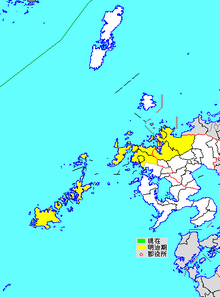| 松浦郡 | |
|---|---|
 | |
| Today part of | Nagasaki prefecture, Saga prefecture |
Matsura-gun is a historical county in Japan. It was located in Hizen Province.
The Matsura region, Sayohime's alluded place of origin, spans the current-day Nagasaki and Saga Prefectures. However, the specific mountaintop that had been dubbed Hirefurinomine (領巾麾嶺, "Scarf-Waving Peak"), as attested in the Man'yōshū, has been identified as the summit of Mount Kagami [ja], on the eastern edge of the city of Karatsu, Saga.
Some versions of the legend of Matsura Sayohime(var. Lady Otohi or Otohi-hime) are classed as the Miwasan-kei setsuwa (三輪山型説話, "stories of the Mt. Miwa pattern") But there is no enduring sign of snake worship in the original vicinity of the legend in the Matsura region, where a local shrine houses the supposed petrified remains, or bōfuseki (望夫石, "rock that contemplates the husband"), of Lady Matsura.
Kagami Shrine was the main shrine and Soja shrine of Matsura-gun
See also
Notelist
- Japanese sources state the mountain overlooks Karatsu Bay (Karatsu wan [ja]), whereas Cranston says there is a view to "Matsura Bay". It is not entirely clear whether he meant Matsura-gata (松浦潟) on the current map (a "lagoon" which is part of Karatsu Bay), or the old name Matsura-wan (松浦湾) which is somewhat ambiguous.
- Cranston remarks that a myth similar to the "Grave of Chopstick" myth above (his tale 122) has been interpolated, but other scholars prefer to compare the Lady Otohi legend to "The Mt. Miwa Story" because they both share the motif of the lady attaching a thread to her husband to discover his true identity to be a snake. Kelsey does not categorize this as a god-husband tale, i.e., the , pp. 219, 232, lists it instead among the "Violent Deities", subtype "IV. Sexual Violence" , p. 231.
- Sayohime Shrine, part of Tashima Shrine.
References
- Yoshida, Keiichi (1968). "A Historico-geographical Study of Western Part of Matsuura-gun in Hizen Province". Japanese Journal of Human Geography. 20 (5): 570–586. doi:10.4200/jjhg1948.20.570.
- Kimbrough (2013), p. 60.
- Nagano (1974), p. 1.
- ^ "Hirefurinomine" ひれふりのみね【褶揺峰・領巾麾嶺】. Seisen-ban Nihon kokugo daijiten. Shogakukan. 2006.
- ^ Cranston, Edwin A. (1998). The Gem-Glistening Cup. Stanford University Press. pp. 142–143. ISBN 978-0-8047-3157-7.
- ^ Nagano, Kazuo (1974), "Hirefurinomine no jijitsu to kyokō" 褶振峯説話の事実と虚構, 国文学研究 (in Japanese) (53): 1, 5, ISSN 0389-8636 alt pdf@core.ac.uk
Bibliography
- Wondrous Brutal Fictions: Eight Buddhist Tales from the Early Japanese Puppet Theater. Translated by Kimbrough, R. Keller. Columbia University Press. 16 April 2013. pp. 161–189. ISBN 978-0-231-14658-6.